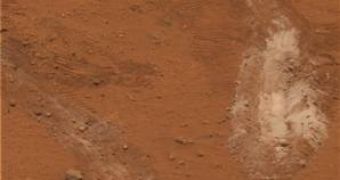A sample of Martian soil collected and analyzed by NASA's Spirit Rover represents the strongest evidence yet that Mars was once a wet planet. The patch underwent thorough analysis and was found to be rich in silica, a chemical compound that needs water to be produced.
MER-A (Mars Exploration Rover - A), a.k.a Spirit, is the first of the two rovers of NASA's Mars Exploration Rover Mission to land successfully on Mars. Using its robotic arm to drill and pick up soil and rock samples and science instruments mounted on it, the rover measured a composition of about 90 percent pure silica - a material commonly found in quartz on Earth - for the bit of Martian dirt, said mission officials.
"You could hear people gasp in astonishment," said Steve Squyres, principal investigator for NASA's twin Spirit and Opportunity rovers at Cornell University in Ithaca, N.Y. "This is a remarkable discovery."
It was indeed an unexpected discovery especially since the space probe encountered a technical difficulty, which caused one of Spirit's six wheels to stop rotating, gouging a deep impression as it drags through soil.
In fact, the drag marks from the wheels exposed several patches of bright soil and produced some of Spirit's biggest discoveries, made at the Gusev Crater exploration site, the latest one included.
The possible formation processes of the silica were either by soil interacting with volcanic acid vapors in the presence of water, or in pure water in a hot spring environment, as NASA declared.
"We've looked at dozens of disturbed soil targets in the rover tracks, and this is the first one that shows a high silica signature," said Steve Ruff of Arizona State University in Tempe, the first scientist to propose using Spirit's thermal emission spectrometer to study the overturned soil's mineral composition last month.
This is the most recent and compelling evidence that ancient conditions may have been favorable for life on Mars and that liquid water may have been an important part of the Martian landscape.

 14 DAY TRIAL //
14 DAY TRIAL //